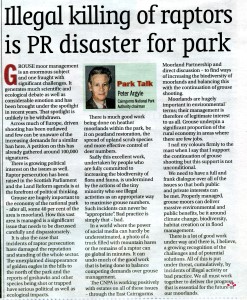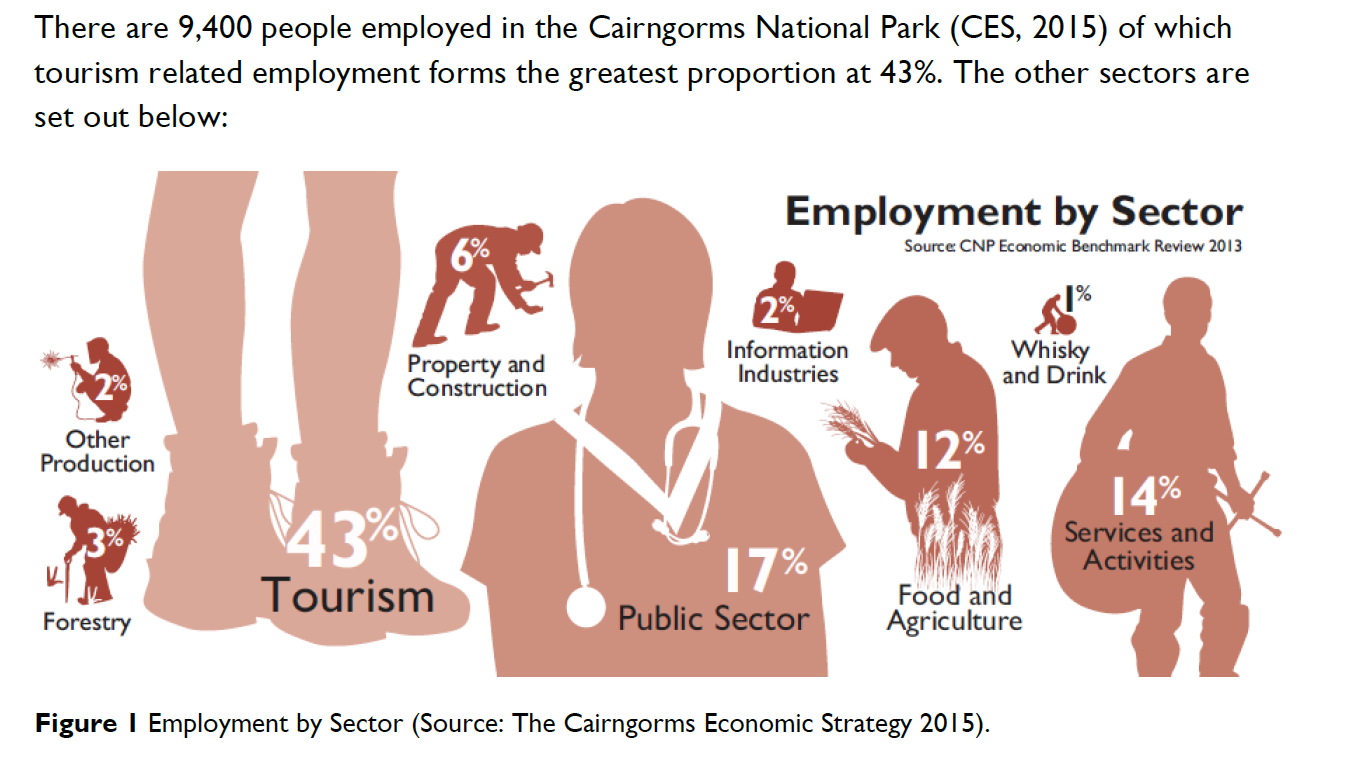 Raptor Persecution Scotland picked up (see here) on a Cairngorms blog piece and article in the Strathspey and Badenoch Herald by Peter Argyle, Convener of the the Cairngorms National Park Authority.
Raptor Persecution Scotland picked up (see here) on a Cairngorms blog piece and article in the Strathspey and Badenoch Herald by Peter Argyle, Convener of the the Cairngorms National Park Authority.
I believe Peter’s contribution is very welcome and its very refreshing that as Convener of the National Park he seems prepared to engage in public debate, unlike his counterpart, Linda McKay, at the Loch Lomond and Trossachs Park Authority where everything is sorted out with preferred partners in secrecy and behind closed doors.
I thought it interesting that Peter has not referenced any of the powers the CNPA has to address the widespread raptor persecution that takes place in the National Park. I have argued how these could be used before (see here) but there is now a very interesting precedent just to the North in Moray where the creation of bye-laws and permits for shooting geese at Findhorn has been supported by none less than the British Association for Shooting and Conservation and Richard Lochhead, the Scottish Government Cabinet Secretary who was responsible for National Parks until earlier this year:
“Following his meeting with Basc, Mr Lochhead argued it was “absolutely clear” the existing regulations weren’t working properly.
And he has now encouraged councillors to impose a permit system with certain by-laws to satisfy parties on either side of the debate.
Mr Lochhead said: “There’s been a backlash in the local community due to some visitors not respecting the local environment, and it’s absolutely clear the status quo is not an option.
“My meeting with Basc was positive and they made it clear they support a permit system with by-laws.
“We need the council to adopt a can-do attitude and calculate the costs of a permit system to inform the debate.
“The shooting season is under way and I don’t think anyone wants to see another season go by without a solution being put in place.”
Basc Scotland’s Donald Muir added: “We explained that a permit system should be put in place at Findhorn Bay, which should eliminate any bad practice taking place.”
(from Press and Journal ((see here))
So why doesn’t the CNPA adopt a similar type of can-do attitude as Richard Lochhead is calling on Moray to adopt?
I also think Peter and the CNPA have got the economic contribution that moorland management makes to the National Park wrong. It is now very profitable, in part because the financiers are enamoured with grouse shooting (Fred Goodwin when running the Royal Bank of Scotland as his personal fiefdom loved to put on his plus fours and go shooting as told by Ian Fraser in “Shredded: Inside RBS the bank that broke Britain) and have both invested in estates and pay large amounts for a day’s shooting (£9,943 per day compared to £729 per day of stag shooting according to the Cairngorms Estates survey in £2014). This has resulted in a shift from deer management to grouse shooting as shown by Andy Wightman and Ruth Tangay in “Research into the Intensification of Grouse Moor Management”. Unfortunately the CNPA have completely failed to provide a similar overall analysis for the Partnership Plan and I think if they did, it would show that most of the alleged benefits grouse moor management brings to the National Park are myths.
Peter Argyle acknowledges that driven grouse shooting has been banned in much of the rest of Europe but does not say why its a problem. Driven grouse shooting is just like a glorified clay pigeon shoot the difference being the supply of targets is limited. This might not matter to most people but grouse shooting is about conspicuous consumption and among the shooters part of the “fun” is downing more grouse than the person next door. The numbers of grouse are extremely important and this is what has driven the intensification of grouse moor management including raptor persecution. While the CNPA has been trying to talk to estates, the ground rules have been changing beneath their feet and as a result they are always on the back foot. If the CNPA introduced a permit system and limited the numbers of grouse that could be shot in a day they could stop this completely and “de-intensify” grouse moor management.
Peter seems to fear that if grouse shooting was tackled there would be a loss of jobs. The evidence suggests that while grouse shooting is now extremely profitable, most of the profit is not invested in the National Park but elsewhere. There is a complete myth that grouse shooting is essential to maintain jobs in remote areas. The pay of estate staff, often working in very difficult conditions, is lamentable (Andy Wightman found the average salary was £11401 and this would seem to accord with the CNPA’s own findings that wages in the National Park are 26% lower than elsewhere in Scotland). The obvious question, which is not being asked by the CNPA, is whether alternative land-uses which depended on the natural rather than the highly managed qualities of the National Park could provide more and better paid jobs which kept money in the local area? Surely this is the sort of question the CNPA should be considering under its mandate to promote sustainable economic development?
The CNPA has produced lots of information on economic development but what is conspicuous by its absence in the Partnership Plan is the absence of any analysis of the role of sporting estates. Part of the reason for this that while previous economic surveys have identified “game management” as one of the most distinctive economic activities in the National Park, it has not been analysed as such but included partly under the tourism sector and partly under food and drink. So, the dominant land-uses in the National Park simply disappear from the economic analysis as this graphic from the draft plan and the quote below illustrates:

The result is the draft Plan, instead of looking at the economics of sporting estates and how this impacts on it priority issues of landscape scale conservation and deer and moorland management, comes up with this non-plan:
Deer and moorland management is a significant aspect of the local economy and culture for many people living in the National Park. The fact that estates invest heavily in deer and moorland management is clearly demonstrated in the landowners’ survey carried out in 2013. This currently supports jobs in sometimes remote locations. Investment in moorland management is a personal choice often driven by a range of external social and economic motivations. Changes to any model of land use carries risks and uncertainties about how alternatives are funded, particularly for individual businesses. Therefore the long term viability and continued employment opportunities must be integral to addressing any changes, to maintain viable land management with investment in public interest outcomes. There is a good opportunity in the National Park to explore new approaches to combining the value of sport with a high quality environment, maintaining employment and investment.
I welcome Peter Argyle’s call for a frank dialogue but I think that to take that forward requires a much more rigorous analysis to that presented in the draft Partnership Plan. Peter says in his blog “There is much good work being done on heather moorlands within the Park, be it on peatland restoration, the spread of upland scrub species and more effective control of deer numbers.” I would agree there is good work and also that some people are trying very very hard – I don’t want to belittle the efforts of those who are trying – but unfortunately the Park Plan does not explicitly put these efforts in context:
- 350ha of peatland restoration underway in the National Park, with a target of 2,000 ha by 2018. This is tiny in the context of the National Park and the 2m hectares of peatland in Scotland that is in poor condition.
- 890 hectares of new woodland is tiny within the context that the National Park covers 4528 km2 or 452800 hectares
Is this really good enough for a National Park which should be setting an example to the rest of Scotland?
What the Partnership Plan needs is some much more ambitious targets if the CNPA is to deliver its statutory aims. I hope Peter Argyle will take part in further public dialogue and debate about this.
Excellent analysis!!